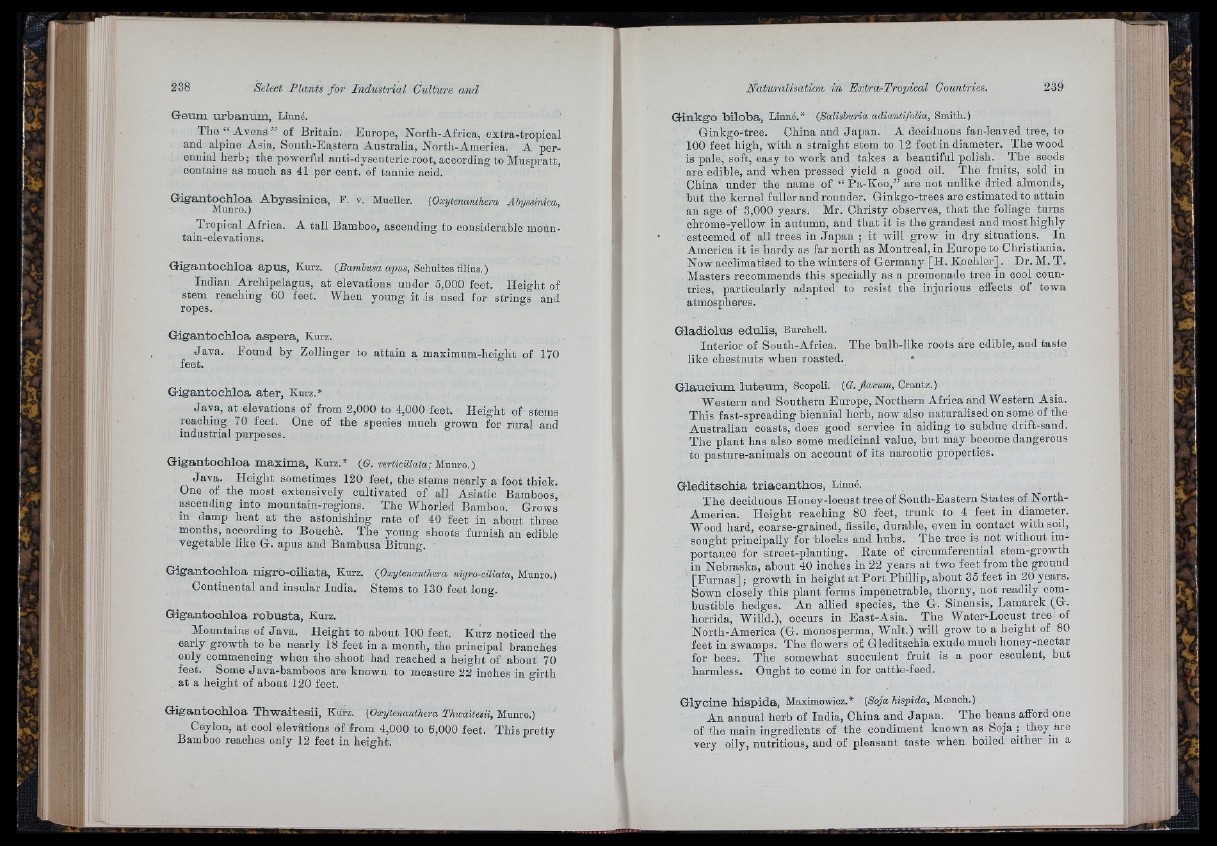
;s 'I
i
L- ! A ‘
fri i i
G e um u r b a n u m , Linné.
ï h e “ Avens ” of Britain. Europe, North-Africa, extra-tropical
and alpine Asia, South-Ea,stern Australia, North-America. A perennial
herb; the powerful anti-dysenteric root, according to Muspratt,
contains as much as 41 per cent, of tannic acid.
G ig a n to o h lo a A b y s s in ic a , F. v. Mueller. (Oxytenanthera Ahyssinica,
Munro. )
Tropical Africa. A tall Bamboo, ascending to considerable moun-
tain-elevations.
G i g a n to c h lo a a p u s , Kurz. opjis, Schultes filius.)
Indian Archipelagus, at elevations under 5,000 feet. Height of
stem reaching 60 feet. When young it is used for strings and
ropes.
G ig a n to c h lo a a s p e r a , Kurz.
Jav a. Found by Zollinger to attain a maximum-height of 170
feet.
G ig a n to c h lo a a t e r , Kurz.*
Jav a , at elevations of from 2,000 to 4,000 feet. Height of stems
reaching 70 feet. One of the species much grown for rural and
industrial purposes.
G ig a n to c h lo a m a x im a , Kurz.* (e . verticillata; Mmao.)
J ava. Height sometimes 120 feet, the stems nearly a foot thick.
One of the most extensively cultivated of' all Asiatic Bamboos,
ascending into mountain-regions. The Whorled Bamboo. Grows
in damp heat at the astonishing rate of 40 feet in about three
months, according to Bouché. The young shoots furnish an edible
vegetable like G. apus and Bambusa Bitiing.
G ig a n to c h lo a n ig r o - c ilia ta , Kurz. (Oxytenanthera nigro-ciliata, Munro.)
Continental and insular India. Stems to 130 feet long.
G ig a n to c h lo a r o b u s t a , Kurz.
Mountains of Jav a . Height to about 100 feet. Kurz noticed the
early growth to be nearly 18 feet in a month, the principal branches
only commencing when the shoot had reached a height of about 70
feet. Some Java-bamboos are known to measure 22 inches in girth
a t a height of about 120 feet.
G ig a n to c h lo a T h w a it e s i i, Kurz. {Oxytenanthera Thwaitesii, Munro.)
Ceylon, at cool elevations of from 4,000 to 6,000 feet. This pretty
Bamboo reaches only 12 feet in height.
G in k g o b ilo b a , Linné.* (Salishuria adiantifoUa, Smith.)
Ginkgo-tree. China and Japan. A deciduous fan-leaved tree, to
100 feet high, with a straight stem to 12 feet in diameter. The wood
is pale, soft, easy to work and takes a beautiful polish. The seeds
are edible, and when pressed yield a good oil. The fruits, sold in
China under the name of “ Pa-Koo,” are not unlike dried almonds,
hut the kernel fuller and rounder. Ginkgo-trees are estimated to attain
an age of 3,000 years. Mr. Christy observes, th a t the foliage turns
chrome-yellow in autumn, and th a t it is the grandest and most highly
esteemed of all trees in Jap an ; it will grow in dry situations. In
America it is hardy as far north as Montreal, in Europe to Christiania.
Now acclimatised to the winters of Germany [H. Koehler]. Dr. M. T.
Masters recommends this specially as a promenade tree in cool countries,
particularly adapted to resist the injurious effects of town
atmospheres.
G la d io lu s e d u lis , Burohell.
Interior of South-Africa. The hulh-like roots are edible, and taste
like chestnuts when roasted.
G l a u c iu m lu te u m , Scopoli. (G. fiavum, Crantr..)
Western and Southern Europe, Northern A frica and Western Asia.
This fast-spreading biennial herb, now also naturalised on some of the
Australian coasts, does good service in aiding to subdue drift-sand.
The plant has also some medicinal value, but may become dangerous
to pasture-animals on account of its narcotic properties.
G l e d it s c h i a t r i a c a n t h o s , Linné.
Th e deciduous Honey-locust tree of South-Eastern States of North-
America. Height reaching 80 feet, trunk to 4 feet in diameter.
Wood hard, coarse-grained, fissile, durable, even in contact with soil,
sought principally for blocks and hubs. The tree is not without importance
for street-planting. Rate of circumferential stem-growth
in Nebraska, about 40 inches in 22 years a t two feet from the ground
[Furnas] ; growth in height a t P o rt Phillip, about 35 feet in 20 years.
Sown closely this plant forms impenetrable, thorny, not readily combustible
hedges. An allied species, the G. Sinensis, Lamarck (G.
hórrida, Willd.), occurs in East-Asia. The Water-Locust tree of
North-America (G. monosperma, Walt.) will grow to a height of 80
feet iu swamps. The flowers of Gleditschia exude much honey-nectar
for bees. The somewhat succulent fruit is a poor esculent, but
harmless. Ought to come in for cattle-feed.
G ly c in e h is p id a , Maximowicz.* {Soja hispida, Mamch.)
An annual herb of India, China and Japan. The beans afford one
of the main ingredients of the condiment known as Soja ; they are
very oily, nutritious, and of pleasant taste when boiled either in a